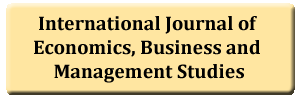Carbon Dioxide Emissions and Economic Growth Nexus in Nigeria: The Role of Financial Development
DOI:
https://doi.org/10.55284/ajssh.v7i2.736Keywords:
Autoregressive distributed lag, CO2 emissions, Economic growth, Energy, Financial development, Interaction marginal effect, Nigeria.Abstract
This study examines the effect of carbon dioxide emissions on economic growth, including investigating whether the CO2-economic growth relationship is dependent on financial development in Nigeria between 1980 and 2020. Due to dwindling economic growth, Nigeria experienced two recessions in one decade. Besides poor growth rates, Nigeria remains a leading emitter of CO2 in the Sub-Saharan region. The motivation for this study derived from the rising level of carbon dioxide emissions in Nigeria which might affect economic growth by dwindling agricultural activities (low output) in some regions, pose health challenges and create a shortage of inputs to agro-allied industries. Hence, this paper attempted to see if there was a causal relationship between carbon dioxide emissions, financial development, and economic growth in Nigeria. The relationship between the variables was examined using the Autoregressive Distributed Lag estimation technique (ARDL) estimation method. The framework for this study has its basis in the endogenous growth theory and utilizes the growth and pollution stock model which showed that sustainable economic growth is influenced by a large stock of pollution (CO2 emission). The results of the boundaries test for cointegration showed a long-term relationship between CO2 emissions, economic expansion, financial development, and energy use. According to empirical data, CO2 emissions have little long-term impact on economic growth. However, there is evidence that the interaction of CO2 emissions and financial development promotes economic growth over the long term, suggesting that CO2 emissions only have an economic influence when there is financial development.




